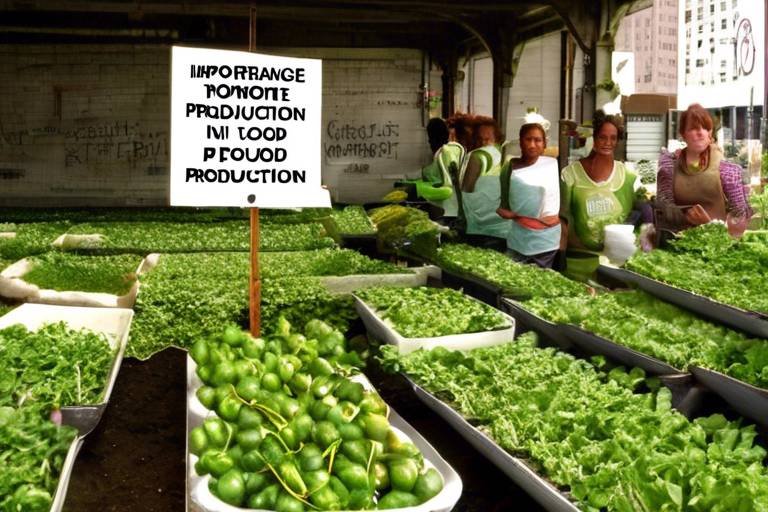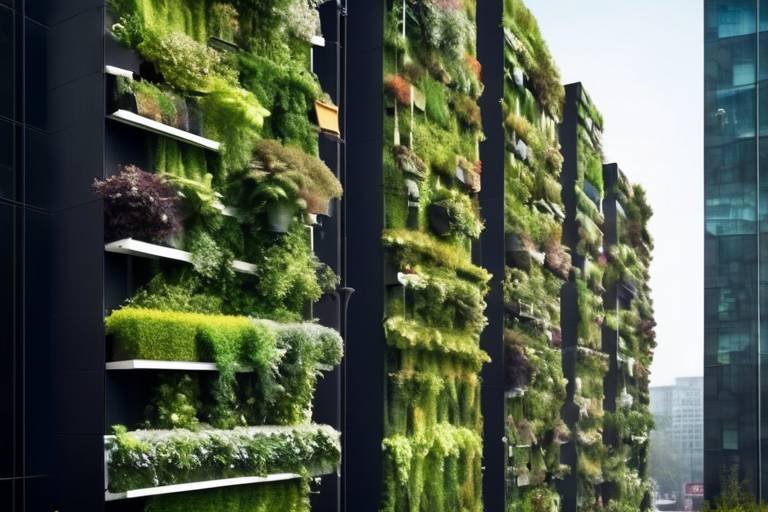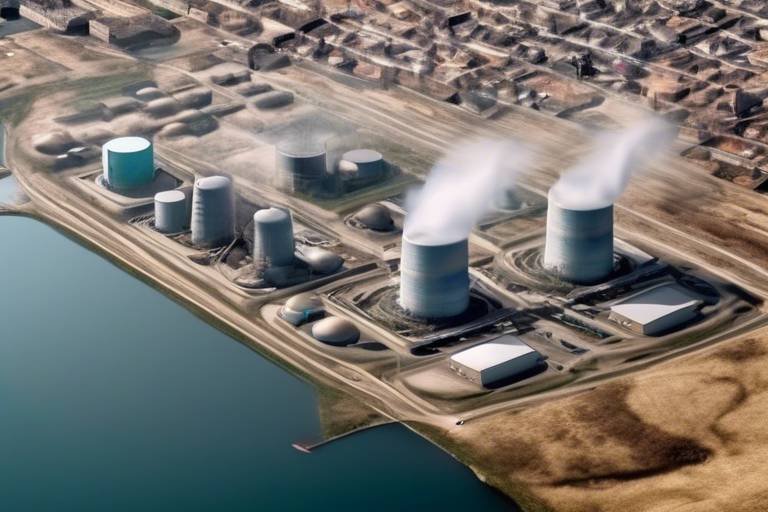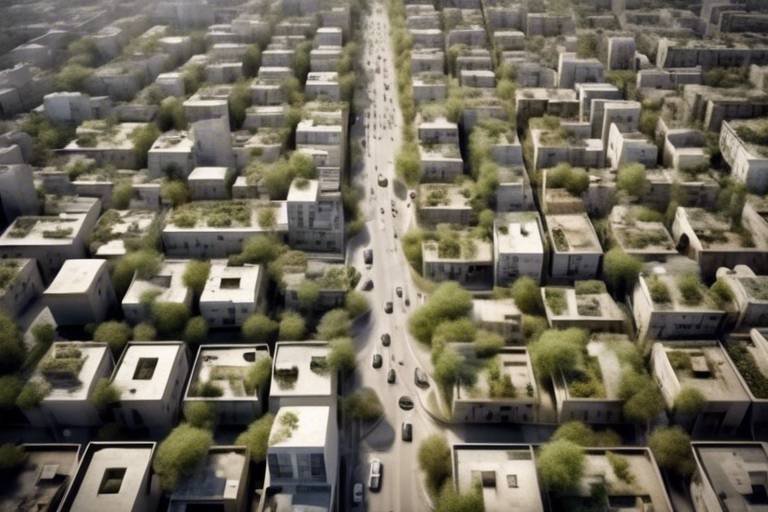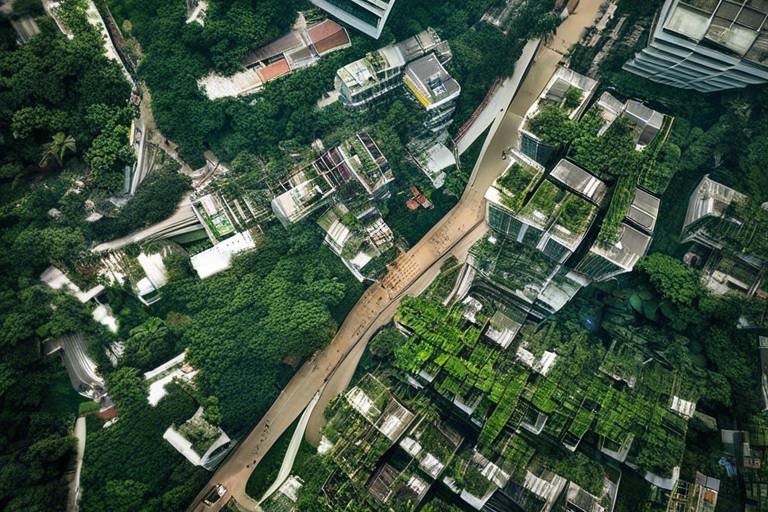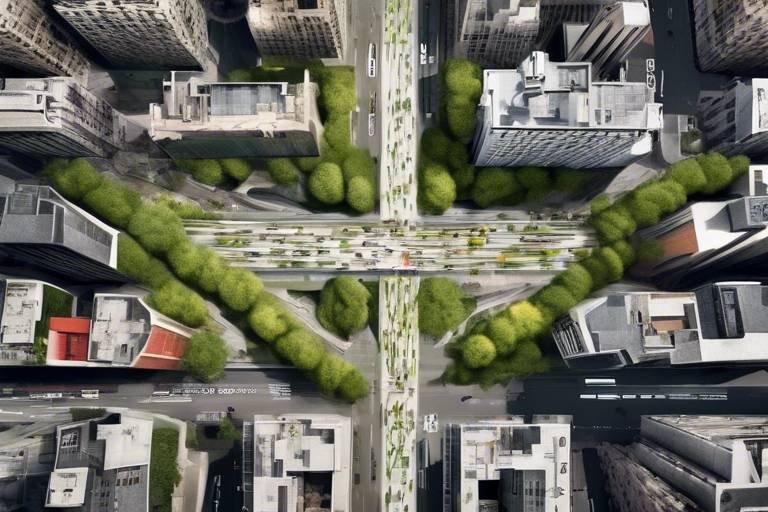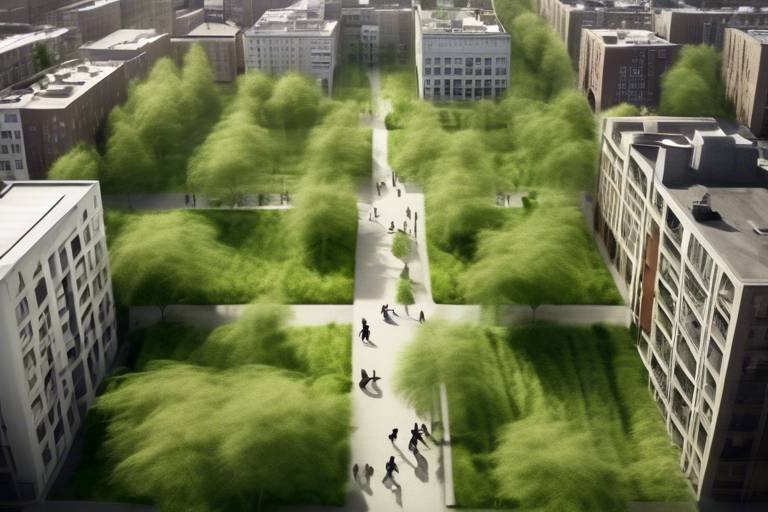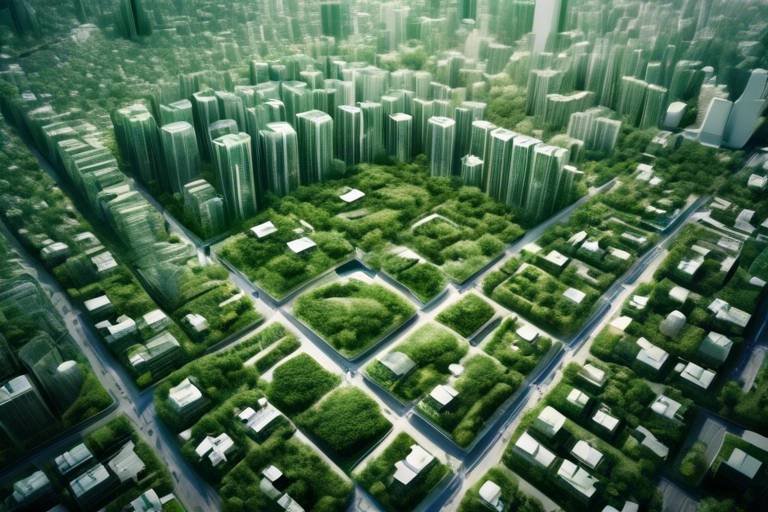The Role of Bees in Urban Sustainability
In the bustling heart of our cities, where concrete jungles rise and green spaces often dwindle, one tiny creature plays a monumental role in ensuring our urban ecosystems thrive: the bee. These remarkable pollinators are not just a charming sight in gardens; they are essential for enhancing urban sustainability. Their contributions extend far beyond honey production, influencing biodiversity, food security, and overall ecosystem health. As we delve into the intricate relationship between bees and urban environments, we uncover how their presence can transform our cities into vibrant, sustainable habitats.
Bees are nature's little superheroes, tirelessly buzzing from flower to flower, facilitating the pollination process that supports a myriad of plant species. In urban settings, this means that bees help maintain and increase plant diversity, which is crucial for creating healthy green spaces. These spaces, in turn, contribute to improved air quality, reduced urban heat, and enhanced aesthetics. Imagine walking through a city park filled with colorful flowers, trees, and shrubs, all thriving thanks to the diligent work of bees. This not only beautifies our surroundings but also enriches our lives, making urban areas more enjoyable and livable.
Moreover, the role of bees in food production cannot be overstated. Many of the fruits, vegetables, and nuts we consume rely on bee pollination. In fact, it’s estimated that one-third of the food we eat is directly or indirectly dependent on these industrious insects. By supporting local agriculture and increasing food security, bees help cities become more self-sufficient and resilient. As urban populations grow, the demand for fresh, locally-sourced produce escalates. Bees are at the forefront of this movement, ensuring that urban farms can flourish and provide healthy food options for residents.
However, the journey of bees in urban landscapes is not without its challenges. As we explore their critical role, it’s imperative to acknowledge the hurdles they face. Urbanization often leads to habitat loss, pollution, and pesticide exposure, all of which threaten bee populations. Understanding these challenges is vital for developing effective strategies to protect and nurture these essential pollinators within our cities. By recognizing the importance of bees and the threats they encounter, we can take meaningful steps towards fostering a more sustainable urban environment.
In conclusion, bees are more than just a part of our natural world; they are a cornerstone of urban sustainability. Their ability to enhance biodiversity, support food production, and contribute to ecosystem health makes them invaluable allies in the quest for greener, more sustainable cities. As we strive to create urban environments that are not only livable but also thriving, let us remember the crucial role that bees play in this delicate balance. Together, we can cultivate a future where bees and humans coexist harmoniously, ensuring the sustainability of our urban landscapes for generations to come.
- Why are bees important for urban sustainability? Bees are vital for pollination, which supports plant diversity and food production, enhancing the overall health of urban ecosystems.
- What challenges do bees face in cities? Urban bees encounter habitat loss, pollution, and pesticide exposure, which threaten their populations and health.
- How can we create bee-friendly spaces in urban areas? By planting bee-friendly plants and designing landscapes that provide habitats, we can support bee populations in cities.
- What are the benefits of urban beekeeping? Urban beekeeping boosts biodiversity, offers educational opportunities, and supports local economies through honey production.
- How can communities get involved in bee conservation? Engaging in local initiatives, participating in workshops, and advocating for bee-friendly policies are great ways to contribute.

The Importance of Bees in Urban Ecosystems
Bees are not just buzzing insects; they are vital contributors to the health and sustainability of urban ecosystems. These tiny pollinators play a significant role in the process of pollination, which is essential for the reproduction of many plants. Without bees, many of the fruits, vegetables, and nuts that we enjoy would become scarce. This is especially critical in urban areas where green spaces are often limited, and food production relies heavily on effective pollination. Imagine walking through a city park filled with vibrant flowers and lush greenery—this beauty is largely thanks to the hard work of bees.
Urban environments can sometimes feel like concrete jungles, but bees help to transform these spaces into thriving ecosystems. They enhance biodiversity by supporting a variety of plant species, which in turn provides habitats for other wildlife. The presence of diverse plant life not only beautifies the city but also promotes a healthier environment for residents. Studies have shown that areas with higher bee populations tend to have more robust plant communities, leading to improved air quality and reduced urban heat.
Moreover, the benefits of bees extend beyond just aesthetics. They contribute to food production in urban settings, which is becoming increasingly important as more people move to cities. Urban agriculture is on the rise, with community gardens and rooftop farms popping up in unexpected places. These initiatives not only provide fresh produce but also rely on bees for pollination. In fact, it is estimated that bees are responsible for pollinating about one-third of the food we eat. So, the next time you bite into a delicious apple or enjoy a juicy strawberry, you can thank the bees for making it possible!
However, the significance of bees goes beyond just food and beauty. They are also indicators of environmental health. A thriving bee population often signifies a balanced ecosystem, while a decline can indicate underlying issues such as pollution or habitat destruction. This makes it crucial for urban planners and policymakers to consider the needs of bees when designing city landscapes.
In summary, bees are integral to urban ecosystems, enhancing biodiversity, supporting food production, and serving as indicators of environmental health. Their role in maintaining the balance of urban life cannot be overstated. As we continue to develop our cities, it is essential to create spaces that not only accommodate human needs but also support these incredible pollinators. After all, a city that supports bees is a city that supports life.

Challenges Facing Urban Bees
Urban environments, while bustling with life and activity, present a unique set of challenges for our buzzing friends, the bees. These challenges can significantly affect their populations and, in turn, the crucial role they play in our ecosystems. One of the primary issues is habitat loss. As cities expand, green spaces are often replaced with concrete jungles, leaving bees with fewer places to nest and forage. This loss of habitat not only limits their access to food sources but also disrupts their natural behaviors.
Moreover, the fragmentation of habitats is another significant concern. When natural areas are split into smaller patches, bees may struggle to find the resources they need to thrive. Imagine trying to find a meal in a city where your favorite restaurants are scattered far apart; that’s what it’s like for bees navigating fragmented habitats. They need larger, connected spaces filled with diverse plants to flourish.
Additionally, urban areas are often rife with pollution. Air and water pollutants can have detrimental effects on bee health, weakening their immune systems and making them more susceptible to diseases. Furthermore, the presence of pesticides in urban landscaping poses a severe threat. These chemicals, designed to eliminate pests, can also harm beneficial insects like bees. The relationship between pesticide use and bee population decline is alarming and calls for immediate attention. Responsible practices must be adopted to protect these vital pollinators.
To address these challenges, cities must recognize the importance of creating bee-friendly environments. This can be achieved by incorporating native plants into urban landscapes, which provide essential food sources for bees. Furthermore, community engagement in conservation efforts is crucial. By educating residents about the importance of bees and how they can help, we can foster a culture of sustainability that benefits both the bees and the community.
In summary, while urban environments present numerous challenges for bees, understanding these issues is the first step toward implementing effective conservation strategies. It’s essential for city planners, policymakers, and residents to come together to create a more sustainable urban ecosystem that supports our buzzing allies.
- Why are bees important for urban areas?
Bees play a vital role in pollination, which supports plant diversity and food production, enhancing the overall health of urban ecosystems. - What can I do to help urban bees?
You can plant native flowers, avoid using pesticides, and create bee-friendly habitats in your garden or community spaces. - How does pollution affect bees?
Pollution can weaken bees' immune systems and lead to diseases, making it harder for them to survive in urban environments. - What are the effects of habitat loss on bees?
Habitat loss limits the resources available to bees, reducing their nesting sites and food sources, which can lead to population decline.

Habitat Loss and Fragmentation
As cities continue to grow and expand, the natural habitats that once thrived are increasingly under threat. Habitat loss and fragmentation are significant challenges for urban bees, making it imperative to understand their impact on these vital pollinators. When we pave over parks, fill in wetlands, and build high-rise apartments, we aren't just changing the skyline; we're also dismantling the ecosystems that support life. Bees, which rely on diverse flora for food and nesting sites, find themselves squeezed into smaller and smaller pockets of green space.
Imagine a vibrant city where bees buzz freely among blooming flowers, contributing to the beauty and health of urban gardens. Now, picture that same city with concrete jungles and limited greenery. The contrast is stark, and the consequences are profound. Fragmented habitats mean that bees must travel further to find food, increasing their energy expenditure and vulnerability to predators. It’s like asking a commuter to take a longer route to work every day without extra time or resources. The journey becomes exhausting, and the risk of not making it home increases.
Furthermore, as habitats are lost, the variety of plants available to bees diminishes. This reduction in biodiversity can lead to a decline in bee populations, as different species of bees have unique dietary needs. For instance, some bees prefer native wildflowers, while others thrive on cultivated plants. When urban planners overlook the importance of maintaining diverse plant life, they inadvertently set the stage for bee decline.
To combat habitat loss and fragmentation, cities can implement several strategies. Creating green corridors that connect existing green spaces can facilitate bee movement and access to resources. These corridors can be as simple as planting native flowers along sidewalks or as elaborate as designing parks that interlink with urban gardens. Additionally, urban planners can prioritize green roofs and vertical gardens, which not only beautify the city but also provide essential habitats for bees.
As we consider the future of urban environments, it's crucial to advocate for policies that prioritize the preservation and restoration of bee habitats. By engaging with local governments and community organizations, we can push for initiatives that support biodiversity and create a sustainable urban ecosystem. Remember, every little effort counts. Even small changes in our own backyards can contribute to a larger movement toward urban sustainability.
- What can individuals do to help urban bees? Planting native flowers, avoiding pesticides, and creating bee-friendly habitats in your garden can make a significant difference.
- Are there specific plants that attract bees? Yes! Plants like lavender, sunflowers, and bee balm are known to attract various bee species.
- How can I get involved in local conservation efforts? Look for local beekeeping clubs or community gardens that focus on sustainability and bee conservation.

Creating Bee-Friendly Spaces
In our bustling urban landscapes, the need to create bee-friendly spaces has never been more critical. As cities expand and natural habitats diminish, it's essential to rethink how we design our environments to accommodate these vital pollinators. Imagine walking through a city park, surrounded by vibrant flowers buzzing with life—this is not just a pleasant sight; it’s a thriving ecosystem that supports bees and enhances our quality of life. So, how do we achieve this? Let’s dive into some practical approaches.
First and foremost, incorporating native plants into urban gardens and landscapes is key. Native plants are adapted to local soil and climate conditions, making them easier to maintain and more attractive to local bee species. For instance, planting flowers like coneflowers, black-eyed Susans, and milkweed can provide essential nectar and pollen sources for bees. These plants bloom at different times throughout the season, ensuring that bees have a continuous food supply.
Furthermore, creating pollinator pathways is an innovative strategy that connects green spaces, allowing bees to travel safely between them. Think of it as a highway for bees! This can be achieved by planting strips of flowers along sidewalks, green roofs, or even community gardens. By doing this, we not only support bee populations but also enhance the beauty and biodiversity of our neighborhoods.
Another effective method is to provide habitat structures for bees. This can include installing bee hotels or leaving patches of bare ground for ground-nesting bees. These structures mimic natural habitats and offer safe places for bees to nest and thrive. In addition, maintaining a diverse range of plant species helps create a more resilient ecosystem, which is crucial for supporting various bee species.
Finally, community involvement plays a significant role in creating bee-friendly spaces. Engaging local residents in planting and maintaining these areas fosters a sense of ownership and responsibility. Educational workshops can empower community members to understand the importance of bees and how they can contribute to their conservation. By working together, we can transform our urban environments into havens for bees and, ultimately, for ourselves.
In conclusion, creating bee-friendly spaces in urban areas is not just about planting flowers; it’s about fostering a culture of sustainability and awareness. When we prioritize the needs of bees, we enhance our urban ecosystems, making our cities healthier and more vibrant places to live. So, let’s roll up our sleeves and get to work—our buzzing friends are counting on us!
- What plants are best for attracting bees? Native wildflowers such as coneflowers, asters, and clover are excellent choices.
- How can I create a bee hotel? You can make a bee hotel using untreated wood, bamboo, or hollow stems to provide nesting sites for solitary bees.
- Is it safe to use pesticides in urban gardens? It's best to avoid pesticides, especially those harmful to bees. Opt for natural pest control methods instead.
- How can I get my community involved in bee conservation? Organize workshops, community planting days, or educational talks to raise awareness about the importance of bees.

Community Engagement in Conservation
Engaging local communities in conservation efforts is not just beneficial; it’s essential for the survival of urban bees. When residents take an active role in protecting and nurturing bee populations, they not only contribute to biodiversity but also foster a sense of ownership and responsibility towards their environment. Imagine a neighborhood where every garden, balcony, and park is buzzing with life—this is the vision that community engagement can help realize.
One of the most effective ways to engage communities is through educational workshops. These workshops can be tailored to different age groups and interests, focusing on the vital role bees play in our ecosystems. For instance, children can learn about the lifecycle of bees through hands-on activities, while adults might explore the benefits of creating bee-friendly gardens. By making the information accessible and fun, communities are more likely to get involved and take action.
Moreover, community-led initiatives can include the establishment of pollinator gardens. These gardens not only provide food and habitat for bees but also serve as a gathering place for residents. They can be designed collectively, allowing community members to choose plants that attract bees and other pollinators. Engaging in such projects fosters collaboration and strengthens community ties, as neighbors work together towards a common goal.
In addition to workshops and gardens, local groups can organize clean-up events and campaigns to reduce pesticide use in their neighborhoods. By educating residents about the harmful effects of pesticides on bee populations, communities can advocate for more sustainable practices. For example, a community might decide to approach local businesses to encourage them to adopt bee-friendly practices, such as using organic pest control methods.
To further enhance community engagement, consider forming a Bee Watch Group. This group can monitor local bee populations, report any concerning declines, and share findings with the community. By involving citizens in data collection, they become more invested in the health of their local ecosystems. The group can also collaborate with local schools, universities, and environmental organizations to broaden their impact and reach.
Ultimately, community engagement in conservation is a powerful tool for creating a sustainable urban environment. When people come together to protect bees, they not only enhance biodiversity but also enrich their own lives and the lives of future generations. As urban areas continue to grow, it’s crucial to remember that every little effort counts. Whether it’s planting a single flower that attracts bees or participating in a larger conservation initiative, every action contributes to a healthier planet.
- Why are bees important for urban environments?
Bees play a critical role in pollinating plants, which is essential for food production and maintaining biodiversity in urban areas. - How can I create a bee-friendly garden?
You can create a bee-friendly garden by planting native flowers, avoiding pesticides, and providing water sources for bees. - What can I do to help local bee populations?
You can help by participating in community initiatives, educating others about bee conservation, and supporting local beekeepers. - Are there any local organizations focused on bee conservation?
Yes, many local environmental organizations focus on bee conservation, and joining one can be a great way to get involved. - How does urban beekeeping benefit the community?
Urban beekeeping increases local biodiversity, provides educational opportunities, and supports the local economy through honey production.

Pesticide Use and Its Effects
Pesticides are a double-edged sword in urban environments. While they are designed to protect crops and manage pests, their use can have serious repercussions on bee populations. Bees are essential pollinators, and their health is directly tied to the health of our ecosystems. Unfortunately, the chemicals found in many pesticides are harmful to these industrious insects. Studies have shown that exposure to certain pesticides can lead to disorientation, impaired foraging abilities, and even increased mortality rates among bee populations.
One of the most concerning aspects of pesticide use is the phenomenon known as "neonicotinoids." These systemic pesticides are absorbed by plants and can remain in the soil for extended periods, making them particularly dangerous for bees. When bees come into contact with contaminated pollen or nectar, they can suffer from neurological damage, which affects their ability to navigate and communicate with their colonies. The impact is not just limited to individual bees; entire colonies can be weakened, leading to decreased reproduction rates and increased vulnerability to diseases.
Moreover, the timing of pesticide application can greatly influence its effects on bees. Many urban gardens and agricultural areas apply pesticides during flowering periods, which coincides with peak bee activity. This creates a perfect storm where bees are exposed to high levels of toxins just when they are foraging for food. The consequences can be devastating, leading to significant declines in bee populations, which in turn affects pollination and biodiversity in urban areas.
To illustrate the alarming effects of pesticides on bees, consider the following table:
| Pesticide Type | Effect on Bees | Duration of Impact |
|---|---|---|
| Neonicotinoids | Neurological damage, disorientation | Months to years |
| Pyrethroids | Acute toxicity, reduced foraging | Days to weeks |
| Herbicides | Indirect harm through habitat loss | Ongoing |
It's crucial for urban dwellers to understand the implications of pesticide use and advocate for more bee-friendly practices. Community awareness can drive change, leading to the adoption of organic gardening methods and integrated pest management strategies that prioritize the health of pollinators. By reducing reliance on harmful chemicals, we can create a safer environment for bees and, ultimately, for ourselves.
In conclusion, the relationship between pesticide use and bee health is complex and fraught with challenges. As urban areas continue to grow, the need for responsible pest management practices becomes increasingly important. By understanding the effects of pesticides and advocating for change, we can work together to protect our vital pollinators and promote urban sustainability.
- What are neonicotinoids? Neonicotinoids are a class of systemic pesticides that are particularly harmful to bees and other pollinators.
- How can I help protect bees in my urban garden? You can reduce pesticide use, plant bee-friendly flowers, and create habitats that support bee populations.
- Are there alternatives to chemical pesticides? Yes, organic pest control methods, such as introducing beneficial insects and using natural repellents, can be effective.

Benefits of Urban Beekeeping
Urban beekeeping is not just a trend; it's a transformative practice that brings a plethora of benefits to our cities and communities. Imagine stepping out onto your balcony or into your backyard and being greeted by the gentle hum of bees at work. These industrious little creatures are not merely producing honey; they are playing a crucial role in enhancing urban biodiversity and sustainability. By integrating beekeeping into urban life, we can witness a remarkable shift in our environment and community dynamics.
One of the most significant advantages of urban beekeeping is the increase in biodiversity. Bees are essential pollinators, and their presence in urban areas helps to support a variety of flowering plants. This, in turn, creates a more vibrant ecosystem. Urban gardens, parks, and green roofs can flourish with diverse plant life, providing habitats for other wildlife as well. It’s like creating a mini-ecosystem within the concrete jungle!
Moreover, urban beekeeping fosters educational opportunities for residents. Many urban beekeeping initiatives include workshops and programs aimed at teaching individuals about the importance of bees and pollination. These educational efforts can spark a newfound appreciation for nature and inspire people to take action in their own communities. Imagine a neighborhood where children learn about the lifecycle of bees while cultivating their own gardens. It’s a beautiful cycle of learning and growth!
Another remarkable benefit of urban beekeeping is the production of local honey. Urban honey is not just delicious; it’s a product that carries the unique flavors of the city’s flora. By supporting local beekeepers, communities can enjoy fresh, organic honey that’s free from the preservatives often found in commercial products. This local honey can be a delicious addition to your morning tea or a sweetener for your favorite recipes. Plus, it’s a fantastic way to support the local economy!
Furthermore, urban beekeeping can enhance community engagement and cohesion. When people come together to maintain beehives, they form bonds and create a sense of belonging. Community gardens that incorporate beekeeping often become social hubs where neighbors collaborate, share resources, and celebrate their achievements. It’s like bringing back the village spirit in an urban setting!
To illustrate the benefits of urban beekeeping, consider the following table that highlights key advantages:
| Benefit | Description |
|---|---|
| Biodiversity | Supports a variety of plants and wildlife, enhancing urban ecosystems. |
| Education | Provides learning opportunities about bees and sustainability. |
| Local Honey | Offers fresh, organic honey that supports local economies. |
| Community Engagement | Fosters collaboration and social connections among residents. |
In conclusion, urban beekeeping is a win-win for both bees and city dwellers. By embracing this practice, we contribute to a healthier environment, promote sustainability, and enrich our communities. So, why not consider becoming a part of this buzzing movement? Your city, and the bees, will thank you!
- What is urban beekeeping? Urban beekeeping involves maintaining bee colonies in urban areas for honey production and pollination support.
- Is it safe to keep bees in the city? Yes, with proper management and education, keeping bees in urban areas can be safe and beneficial.
- How can I get involved in urban beekeeping? You can start by joining local beekeeping associations or participating in community workshops.
- What plants are best for attracting bees? Flowering plants such as lavender, sunflowers, and wildflowers are excellent for attracting bees.

Educational Programs and Workshops
Urban beekeeping initiatives are not just about keeping bees; they are about creating a community that understands and values the essential role these pollinators play in our ecosystems. One of the most effective ways to foster this understanding is through . These initiatives serve as a bridge, connecting residents with the fascinating world of bees and empowering them to take part in conservation efforts.
Imagine walking into a workshop buzzing with excitement, where participants of all ages gather to learn about the intricate lives of bees. These programs often cover a range of topics, from the basics of beekeeping to the critical importance of bees in our food systems. By engaging in hands-on activities, such as building bee hotels or extracting honey, participants gain a deeper appreciation for these incredible insects. This experiential learning approach not only makes the information stick but also encourages participants to share their newfound knowledge with others.
Moreover, educational workshops can play a pivotal role in dispelling common myths about bees. For instance, many people fear bees due to misconceptions about their aggression. Through these programs, attendees learn that most bees are gentle and crucial for pollination. Understanding the difference between bees and wasps, for example, can alleviate fears and promote coexistence. By addressing these misconceptions head-on, we can create a more bee-friendly mindset within urban communities.
In addition to in-person workshops, many organizations are now leveraging technology to reach a broader audience. Online courses and webinars allow individuals who may not be able to attend physical workshops to participate in learning. This flexibility means that anyone, anywhere can become a bee advocate, further expanding the reach of these educational efforts.
To give you a clearer picture of the impact of these programs, consider the following table that outlines some common topics covered in educational workshops:
| Workshop Topic | Description |
|---|---|
| Introduction to Beekeeping | A beginner's guide to starting your own hive, including equipment and maintenance. |
| Pollination and Biodiversity | Understanding the crucial role bees play in pollinating plants and supporting ecosystems. |
| Bee Health and Safety | Learning how to keep bees healthy and safe from diseases and pests. |
| Honey Harvesting | Step-by-step guidance on how to harvest honey sustainably. |
These workshops not only educate but also inspire action. Many participants leave with the motivation to start their own hives or to plant bee-friendly gardens in their backyards. This ripple effect is vital for increasing bee populations and enhancing urban biodiversity.
Furthermore, community engagement through educational programs fosters a sense of ownership and responsibility towards local ecosystems. When people understand the challenges that bees face, such as habitat loss and pesticide exposure, they are more likely to advocate for policies that protect these essential creatures. In this way, education becomes a powerful tool for change, driving both individual and collective action toward sustainable urban living.
In conclusion, educational programs and workshops are essential for promoting bee conservation in urban areas. They not only equip individuals with knowledge but also inspire a community-wide movement towards sustainability. By nurturing a culture of learning and stewardship, we can ensure that bees continue to thrive in our cities, enhancing biodiversity and contributing to healthier environments for all.
- Why are bees important for urban environments? Bees play a critical role in pollinating plants, which supports biodiversity and food production in cities.
- How can I get involved in local beekeeping? Look for workshops and community initiatives in your area that offer training and support for new beekeepers.
- What can I do to create a bee-friendly garden? Plant native flowers, avoid using pesticides, and consider adding bee hotels to provide shelter for solitary bees.
- Are urban bees different from rural bees? Urban bees may face unique challenges, such as habitat fragmentation and pollution, but they are equally important for pollination.

Local Honey Production and Economy
Urban beekeeping is more than just a trend; it's a movement that brings a wave of benefits to both the environment and local communities. One of the most delightful outcomes of this practice is the production of local honey. This golden elixir does not just sweeten our teas; it plays a pivotal role in boosting the local economy. Think about it: when residents engage in beekeeping, they create a sustainable source of income right in their backyards. Local honey production fosters entrepreneurship, allowing individuals to sell their products at farmers' markets, local shops, and even online.
The economic impact of local honey production can be significant. Not only does it provide a source of income for beekeepers, but it also encourages consumers to buy local, which keeps money circulating within the community. When you purchase honey from a local beekeeper, you're not just getting a jar of sweetness; you're supporting a whole ecosystem of small businesses, including those that provide beekeeping supplies and related products.
Moreover, local honey production has the added benefit of promoting biodiversity. Bees, while busy pollinating flowers, inadvertently contribute to the flourishing of local flora, which in turn supports a variety of wildlife. This interconnectedness means that the more successful local honey production becomes, the healthier the urban ecosystem grows. It's a win-win situation!
But let's not forget about the health benefits of local honey. Many people prefer it because it's often raw and unprocessed, which means it retains all the natural enzymes and nutrients. Additionally, consuming local honey can help with seasonal allergies, as it exposes individuals to local pollen, potentially reducing their sensitivity over time. This unique aspect of local honey makes it a sought-after product, further driving demand and economic growth.
To illustrate the economic potential of urban honey production, consider the following table that outlines some of the key benefits:
| Benefit | Description |
|---|---|
| Income Generation | Local beekeepers can sell honey and other bee-related products, providing a source of income. |
| Support for Local Businesses | Purchasing local honey supports a network of local suppliers and businesses. |
| Health Benefits | Local honey can help with allergies and is often raw and unprocessed. |
| Biodiversity Promotion | Bees contribute to the pollination of local plants, enhancing urban biodiversity. |
In conclusion, the integration of beekeeping into urban life not only enriches our diets with delicious local honey but also strengthens our communities economically. It's a sweet cycle of sustainability that benefits everyone—from the bees buzzing around to the people enjoying the fruits of their labor. So, the next time you savor a spoonful of honey, remember that you're supporting a vibrant local economy and a healthier planet.
- What is urban beekeeping? Urban beekeeping refers to the practice of keeping bee colonies in urban areas, typically on rooftops, gardens, or other small spaces.
- How does local honey differ from store-bought honey? Local honey is often raw and unprocessed, containing more nutrients and local pollen, which can help with allergies.
- Can anyone start beekeeping in the city? Yes, but it's essential to check local regulations and guidelines regarding beekeeping in your area.
- What are the benefits of supporting local beekeepers? Supporting local beekeepers helps sustain local economies, promotes biodiversity, and provides access to healthier honey options.

Policy and Advocacy for Bee Protection
Advocating for policies that protect bees is not just a noble cause; it's a necessity for ensuring urban sustainability. As cities grow and evolve, the need for comprehensive legislation that prioritizes bee conservation becomes increasingly urgent. Bees play an essential role in our ecosystems, and their decline can have far-reaching consequences for biodiversity and food security. But how can we, as urban dwellers, influence policy and promote practices that safeguard these vital pollinators?
First and foremost, understanding the connection between legislation and bee health is crucial. Many urban policies, from land use to agricultural practices, can directly impact bee populations. For instance, zoning laws that encourage the planting of native flora can create habitats that support bees. Similarly, regulations limiting pesticide use in residential areas can significantly reduce the harmful exposure that bees face. By advocating for such policies, we can create a more bee-friendly urban environment.
One effective way to promote bee protection is through community advocacy. Grassroots movements have the power to influence local government decisions. By organizing community events, such as bee awareness days or workshops, residents can educate each other about the importance of bees and the threats they face. These initiatives not only raise awareness but also build a collective voice that can pressure local authorities to take action. For example, a community petition for the creation of bee sanctuaries in local parks can lead to significant changes in urban planning.
Moreover, collaborating with environmental organizations can amplify our efforts. Many non-profits focus on pollinator protection and can provide resources and support for local advocacy campaigns. By partnering with these organizations, community members can access expert knowledge and tools to effectively push for change. They can help organize campaigns that target specific legislation, such as the introduction of bee-friendly landscaping guidelines or the establishment of pesticide-free zones.
It's also vital to engage with policymakers directly. Attending town hall meetings, participating in public comment periods, and contacting local representatives are all effective ways to voice concerns about bee conservation. When citizens express their commitment to protecting bees, it sends a strong message to decision-makers that this issue matters to the community. Furthermore, developing relationships with local officials can facilitate ongoing discussions about bee protection and lead to more informed policymaking.
To summarize, the path to effective bee protection in urban areas is paved with advocacy and community engagement. By understanding the impact of policy on bee health, organizing grassroots movements, collaborating with environmental organizations, and engaging with policymakers, we can create a sustainable future for bees in our cities. The survival of these pollinators is not just a concern for environmentalists; it’s a collective responsibility that impacts us all.
- Why are bees important for urban sustainability?
Bees are crucial for pollination, which supports plant diversity and food production, enhancing the quality of life in urban environments. - What are the main challenges facing urban bees?
Urban bees face habitat loss, pollution, and pesticide exposure, all of which threaten their populations. - How can I help protect bees in my community?
You can advocate for bee-friendly policies, create habitats in your garden, and support local beekeepers. - What role do local governments play in bee conservation?
Local governments can implement policies that protect bee habitats, regulate pesticide use, and promote biodiversity in urban planning.
Frequently Asked Questions
- Why are bees important for urban environments?
Bees play a crucial role in pollination, which supports plant diversity and food production in cities. Their presence not only enhances urban green spaces but also contributes to healthier ecosystems and a better quality of life for residents.
- What challenges do bees face in urban areas?
Urban bees encounter several challenges, including habitat loss due to city expansion, pollution, and pesticide exposure. These factors threaten their populations and highlight the need for effective conservation strategies.
- How can we create bee-friendly spaces in cities?
Designing urban landscapes with bee-friendly plants and habitats is essential. This can include planting native flowers, creating community gardens, and installing bee hotels, which provide safe nesting sites for solitary bees.
- What role does community engagement play in bee conservation?
Engaging local communities in conservation efforts fosters awareness and encourages action. Initiatives like workshops, community gardens, and educational programs help residents understand the importance of bees and how to support them.
- How do pesticides affect bee populations?
Pesticides can have harmful effects on bee health, leading to population decline. Understanding the relationship between pesticide use and bee mortality is crucial for promoting responsible practices and protecting these vital pollinators.
- What are the benefits of urban beekeeping?
Urban beekeeping supports bee populations and offers numerous benefits, such as increased biodiversity, educational opportunities, and local honey production. It creates a connection between communities and nature while boosting local economies.
- How can educational programs help with bee conservation?
Educational programs and workshops teach residents about the importance of bees and sustainable practices. They raise awareness and inspire individuals to participate in conservation efforts, ultimately fostering a culture of sustainability.
- What policies can protect bees in urban settings?
Advocating for policies that promote bee-friendly practices is essential for their protection. This includes legislation that limits pesticide use, supports habitat restoration, and encourages urban agriculture, ensuring a safe environment for bees.


